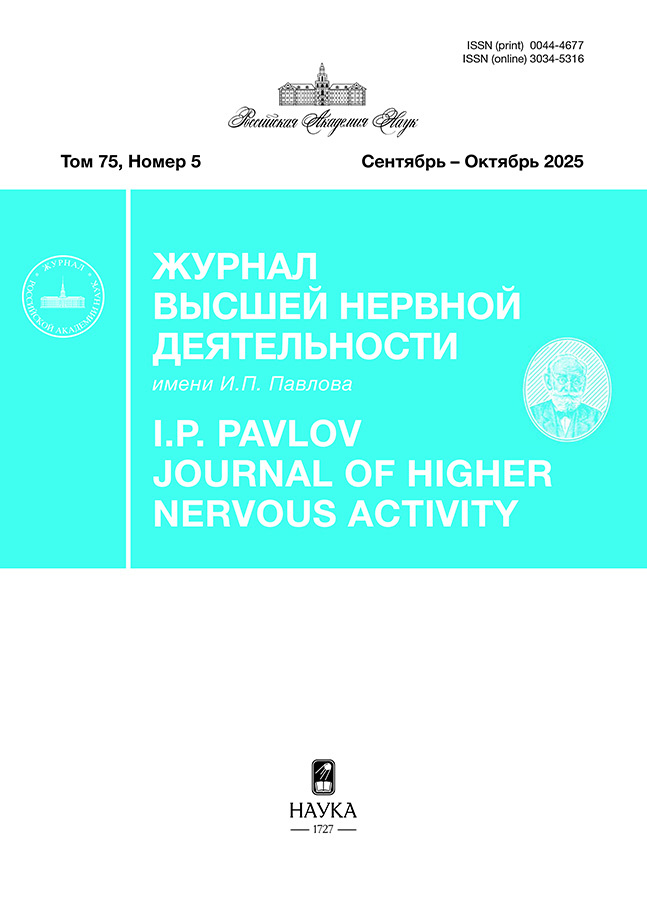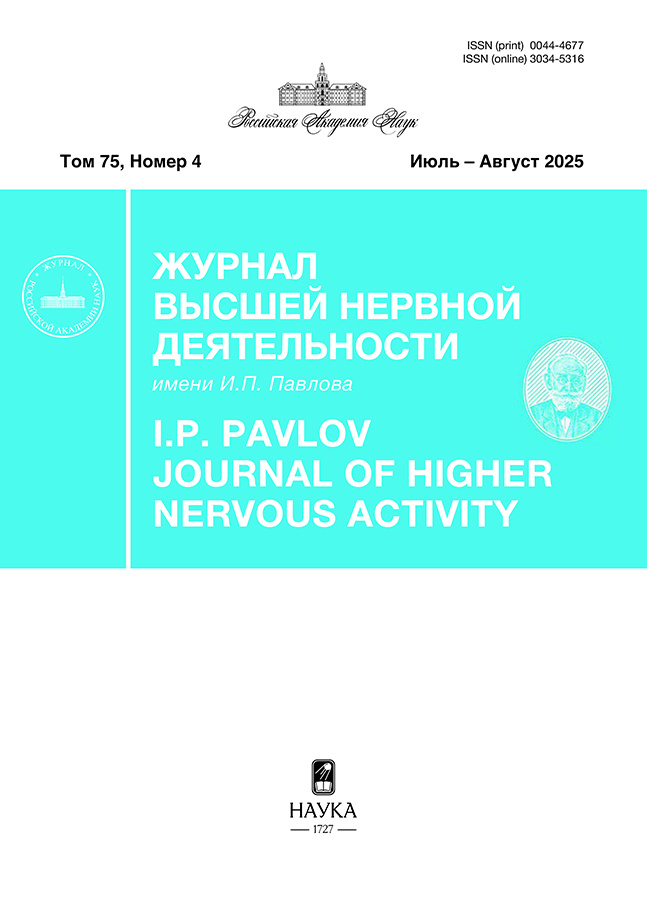Колебательные ответы в тета-диапазоне на начало и остановку циклического движения звуковых стимулов
- Авторы: Шестопалова Л.Б.1, Петропавловская Е.А.1, Летягин П.И.1, Саликова Д.А.1
-
Учреждения:
- Федеральное государственное бюджетное образовательное учреждение науки Институт физиологии им. И.П. Павлова РАН
- Выпуск: Том 75, № 4 (2025)
- Страницы: 435-449
- Раздел: ФИЗИОЛОГИЯ ВЫСШЕЙ НЕРВНОЙ (КОГНИТИВНОЙ) ДЕЯТЕЛЬНОСТИ ЧЕЛОВЕКА
- URL: https://rjsocmed.com/0044-4677/article/view/687509
- DOI: https://doi.org/10.31857/S0044467725040042
- ID: 687509
Цитировать
Полный текст
Аннотация
В настоящем исследовании был проведен вейвлет-анализ ЭЭГ при циклическом движении звуковых стимулов. Регистрировали ЭЭГ при пассивном прослушивании стимулов с циклическими изменениями межушных временных различий (ΔT), разработанных для моделирования бинауральных биений. Были проанализированы изменения спектральной мощности (ERSP) и фазовой когерентности (ITC) колебательной активности, которая лежит в основе реакции на начало движения (motion-onset response, MOR) и на окончание движения (omitted-stimulus response, OSR). В ответе на начало движения наибольшие значения ERSP и ITC тета-колебаний были зафиксированы при центральном расположении стимула, в то время как при отклонении его положения на 45 и 90 градусов значения этих показателей снижались. Чувствительность ERSP и ITC к положению начальной точки наиболее выражена в отведениях правого полушария. Ответы на окончание движения не зависели от положения стимула в пространстве и были связаны с фазовой синхронизацией (ITC) тета-колебаний, продолжающейся после остановки движения.
Ключевые слова
Полный текст
Об авторах
Л. Б. Шестопалова
Федеральное государственное бюджетное образовательное учреждение науки Институт физиологии им. И.П. Павлова РАН
Автор, ответственный за переписку.
Email: shestopalovalb@infran.ru
Россия, Санкт-Петербург
Е. А. Петропавловская
Федеральное государственное бюджетное образовательное учреждение науки Институт физиологии им. И.П. Павлова РАН
Email: shestopalovalb@infran.ru
Россия, Санкт-Петербург
П. И. Летягин
Федеральное государственное бюджетное образовательное учреждение науки Институт физиологии им. И.П. Павлова РАН
Email: shestopalovalb@infran.ru
Россия, Санкт-Петербург
Д. А. Саликова
Федеральное государственное бюджетное образовательное учреждение науки Институт физиологии им. И.П. Павлова РАН
Email: shestopalovalb@infran.ru
Россия, Санкт-Петербург
Список литературы
- Варфоломеев А.Л., Старостина Л.В. Слуховые вызванные потенциалы человека при иллюзорном движении звукового образа. Рос. физиол. журн. им. Сеченова. 2006. 92 (9): 1046–1057.
- Шестопалова Л.Б., Петропавловская Е.А. 2024. Вызванные потенциалы на движение звуковых стимулов при межушных различиях по интенсивности. Журн. высш. нерв. деят. им. И.П. Павлова. 2024. 74 (3): 311–323.
- Шестопалова Л.Б., Петропавловская Е.А., Семенова В.В., Никитин Н.И. Ритмическая активность мозга человека, связанная с движением звуковых стимулов. Журн. высш. нерв. деят. им. И.П. Павлова. 2020. 70 (5): 616–634.
- Шестопалова Л.Б., Петропавловская Е.А., Летягин П.И., Саликова Д.А. Вызванные потенциалы при циклическом движении звукового сигнала. Журн. высш. нерв. деят. им. И.П. Павлова. 2025. №3 (в печати).
- Шестопалова Л.Б., Петропавловская Е.А., Саликова Д.А., Летягин П.И. Воспринимаемые траектории циклического движения звуковых образов. Сенсорные системы. 2024a. 38 (3): 51–62.
- Шестопалова Л.Б., Петропавловская Е.А., Саликова Д.А., Летягин П.И. Локализация точек поворота при ритмическом движении звукового образа. Физиология человека. 2024b. 50 (5): 3–12.
- Шестопалова Л.Б., Семенова В.В., Петропавловская Е.А. Вызванный
- ответ мозга человека на начало движения звука (motion-onset response). Успехи Физиол. наук. 2024с. 55 (3): 22–44.
- Ahissar M.V., Ahissar E., Bergman H., Vaadia E. Encoding of sound-source location and movement: activity of single neurons and interactions between adjacent neurons in the monkey auditory cortex. J. Neurophysiol. 1992. 67: 203–15.
- Akeroyd M.A. A binaural beat constructed from a noise. J. Acoust. Soc. Am. 2010. 128: 3301–4.
- Auksztulewicz R., Rajendran V.G., Peng F., Schnupp J.W.H., Harper N.S. Omission responses in local field potentials in rat auditory cortex. BMC Biology. 2023. 21 (1):130.
- Bernstein L.R., Trahiotis C., Akeroyd M.A., Hartung K. Sensitivity to brief changes of interaural time and interaural intensity. J. Acoust. Soc. Am. 2001. 109 (4): 1604–1615.
- Braga A., Schönwiesner M. Neural substrates and models of omission responses and predictive processes. Front. Neural Circuits. 2022. 16: 799581.
- Briley P.M., Kitterick P.T., Summerfield A.Q. Evidence for Opponent Process Analysis of Sound Source Location in Humans. J. Assoc. Res. Otolaryngol. 2013. 14 (1): 83–101.
- Carlile S., Leung J. The perception of auditory motion. Trends Hear. 2016. 20: 1–19.
- Carlini A., Bordeau C., Ambard M. Auditory localization: a comprehensive practical review. Front Psychol. 2024.15: 1408073.
- Demarchi G., Sanchez G., Weisz N. Automatic and feature-specific prediction-related neural activity in the human auditory system. Nat. Commun. 2019. 10: 3440.
- Forseth K.J., Hickok G., Rollo P.S., Tandon N. Language prediction mechanisms in human auditory cortex. Nature commun. 2020.11: 5240.
- Garcia-Argibay M., Santed M.A., Reales J.M. Efficacy of binaural auditory beats in cognition, anxiety, and pain perception: a meta-analysis. Psychol. Res. 2019. 83(2): 357–372.
- Getzmann S. Effect of auditory motion velocity on reaction time and cortical processes. Neuropsychologia. 2009. 47: 2625–2633.
- Getzmann S. Auditory motion perception: onset position and motion direction are encoded in discrete processing stages. Eur. J. Neurosci. 2011. 33: 1339–1350.
- Getzmann S., Lewald J. Effects of natural versus artificial spatial cues on electrophysiological correlates of auditory motion. Hear Res. 2010. 259: 44–54.
- Getzmann S., Lewald J. Cortical processing of change in sound location: smooth motion versus discontinuous displacement. Brain Res. 2012. 1466: 119–127.
- Grantham D.W., Wightman F.L. Detectability of varying interaural temporal differences. J. Acoust. Soc. Am. 1978. 63: 511–523.
- Hauswald A., Benz K.R., Hartmann T., Demarchi G., Weisz N. Carrier-frequency specific omission-related neural activity in ordered sound sequences is independent of omission predictability. Eur. J. Neurosci. 2024. 60: 3812–3820.
- Hirnstein M., Hausmann M., Lewald J. Functional cerebral asymmetry in auditory motion perception. Laterality. 2007. 12: 87–99.
- Ingham N.J., Hart H.C., McAlpine D. Spatial receptive fields of inferior colliculus neurons to auditory apparent motion in free field. J. Neurophysiol. 2001. 85: 23–33.
- Karamürsel S., Bullock T.H. Human auditory fast and slow omitted stimulus potentials and steady-state responses. Int. J. Neuroscience. 2000. 100: 1-20.
- Kreitewolf J., Lewald J., Getzmann S. Effect of attention on cortical processing of sound motion: An EEG study. NeuroImage. 2011. 54: 2340–2349.
- Krumbholz K., Eickhoff S.B., Fink G.R. Feature- and object-based attentional modulation in the human auditory «where» pathway. J. Cogn. Neurosci. 2007a. 19: 1721–1733.
- Krumbholz K., Hewson-Stoate N., Schönwiesner M. Cortical response to auditory motion suggests an asymmetry in the reliance on inter-hemispheric connections between the left and right auditory cortices. J. Neurophysiol. 2007b. 97: 1649–1655.
- Lao-Rodríguez A.B., Przewrocki K., Pérez-González D., Alishbayli A., Yilmaz E., Malmierca M.S., Englitz B. Neuronal responses to omitted tones in the auditory brain: A neuronal correlate for predictive coding. Sci. Adv. 2023. 9(24): eabq8657.
- Lewald J., Staedtgen M., Sparing R., Meister I.G. Processing of auditory motion in inferior parietal lobule: Evidence from transcranial magnetic stimulation. Neuropsychologia. 2011. 49: 209–215.
- Magezi D.A., Krumbholz K. Evidence for opponent-channel coding of interaural time differences in human auditory cortex. J Neurophysiol. 2010. 104: 1997–2007.
- Malone B.J., Scott B.H., Semple M.N. Context-dependent adaptive coding of interaural phase disparity in the auditory cortex of awake macaques. J. Neurosci. 2002. 22: 4625–4638.
- McAlpine D., Jiang D., Shackleton T.M., Palmer A.R. Responses of neurons in the inferior colliculus to dynamic interaural phase cues: evidence for a mechanism of binaural adaptation. J. Neurophysiol. 2000. 83: 1356–65.
- Neophytou D., Arribas D.M., Arora T., Levy R.B., Park I.M., Oviedo H.V. Differences in temporal processing speeds between the right and left auditory cortex reflect the strength of recurrent synaptic connectivity. PLoS Biol. 2022. 20(10): e3001803.
- Obleser J., Kayser C. Neural entrainment and attentional selection in the listening brain. Trends in Cognitive Sciences. 2019. 23(11): 913–926.
- Ozmeral E.J., Eddins D.A., Eddins A.C. Electrophysiological responses to lateral shifts are not consistent with opponent-channel processing of interaural level differences. J. Neurophysiol. 2019. 122(2): 737–748.
- Perrott D.R., Musicant A.D. Minimum audible movement angle: Binaural localization of moving sound sources. J. Acoust. Soc. Am. 1977. 62 (6): 1463–1466.
- Saberi K., Hickok G. Forward entrainment: Psychophysics, neural correlates, and function. Psychon. Bull. Rev. 2023. 30(3): 803–821.
- Salminen N.H., Tiitinen H., May P.J.C. Auditory Spatial Processing in the Human Cortex. Neuroscientist. 2012. 18 (6): 602–612.
- SanMiguel I., Saupe K., Schröger E. I know what is missing here: electrophysiological prediction error signals elicited by omissions of predicted “what” but not “when”. Front. Hum. Neurosci. 2013. 7. Article 407.
- Shestopalova L.B., Petropavlovskaia E.A., Vaitulevich S.Ph., Nikitin N.I. Hemispheric asymmetry of ERPs and MMNs evoked by slow, fast and abrupt auditory motion. Neuropsychologia. 2016. 91: 465–479.
- Shestopalova L.B., Petropavlovskaia E.A., Semenova V.V., Nikitin N.I. Brain Oscillations evoked by sound motion. Brain Research. 2021a. 1752: 147232.
- Shestopalova L.B., Petropavlovskaia E.A., Semenova V.V., Nikitin N.I. Lateralization of brain responses to auditory motion: A study using single-trial analysis. Neurosci. Res. 2021b. 162: 31–44.
- Teshiba T.M., Ling J., Ruhl D.A., Bedrick B.S., Peña A., Mayer A.R. Evoked and intrinsic asymmetries during auditory attention: implications for the contralateral and neglect models of functioning. Cereb. Cortex. 2013. 23 (3): 560–569.
- Vilà-Balló A., Marti-Marca A., Torralba M., Soto-Faraco S., Pozo-Rosich P. The influence of temporal unpredictability on the electrophysiological mechanisms of neural entrainment. Psychophysiol. 2022. 59(11): e14108.
- Yaron A., Shiramatsu-Isoguchi T., Kern F.B., Ohki K., Takahashi H., Chao Z.C. Omission-responsive neurons encode negative prediction error and probability in the auditory cortex. bioRxiv. 2024.09.09.612166. doi.org/10.1101/2024.09.09.612166.
Дополнительные файлы















